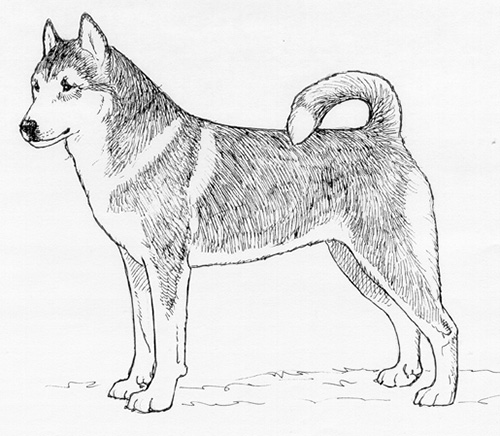Lundehund
Northern Breed Group
The goals and purposes of this breed standard include: to furnish guidelines for breeders who wish to maintain the quality of their breed and to improve it; to advance this breed to a state of similarity throughout the world; and to act as a guide for judges.
Breeders and judges have the responsibility to avoid any conditions or exaggerations that are detrimental to the health, welfare, essence and soundness of this breed, and must take the responsibility to see that these are not perpetuated.
Any departure from the following should be considered a fault, and the seriousness with which the fault should be regarded should be in exact proportion to its degree and its effect upon the health and welfare of the dog and on the dog’s ability to perform its traditional work.
History
The Lundehund, also known as the Puffin Dog and the Norwegian Lundehund, is native to Norway, and is believed to be a very ancient breed.
The breed is believed to have developed certain unique characteristics so it would be better suited for locating the native Puffin nests on the steep rocks around the fjords and along the shore. These characteristics include: extra toes, a double-jointed neck, and extremely flexible forelegs.
The Lundehund was recognized by the United Kennel Club on January 1, 1995.
General Appearance
The Lundehund is a rectangular, small, comparatively light, supple spitz-type dog, with distinct secondary sex characteristics.
Characteristics
It is alert, energetic, and lively of temperament.
Head
The head is clean cut, medium width, and wedge shaped.
SKULL
The skull is slightly domed. The occiput is evident and visible. The stop is pronounced, but not sharp.
MUZZLE
The muzzle is wedge shaped with a slightly convex nasal bridge.
TEETH
A full complement of strong, white teeth meet in a scissors bite. A level bite and a moderate undershot bite are acceptable. A lack of premolars on both sides, on both the top and bottom jaw, is quite common.
EYES
The eye openings are slightly slanted. The eyes do not protrude. The iris is yellowish brown, with the pupil surrounded by a dark halo.
EARS
The triangular ears are of medium size. They are broad at the base, carried erect, and are very mobile.
It is a breed characteristic that the cartilage around the ear opening is able to contract, and the external ear leather is folded and turned up in a peculiar way - backward or at right angles upward so that the ear opening is shut.
Neck
The clean cut, rather strong, medium length neck has a rather rich color. The neck is double-jointed, so that the head can be bent backward, almost touching the back.
Forequarters
The forequarters are moderately angulated.
FORELEGS
The forearms are straight. The forelegs are extraordinarily flexible, being able to turn to the side at 90-degree angles.
Body
The body is rectangular in shape. The back is strong and straight. The croup slopes slightly. The long chest is of medium width; is relatively deep and spacious. There is a slight tuck-up.
Fault: Barrel-shaped chest.
Hindquarters
The hindquarters are moderately angulated and strong.
HIND LEGS
The upper and lower thighs are muscular. The position of the hind legs is somewhat narrow.
Feet
The oval-shaped forefeet turn slightly outward. There are six toes on the forelegs, and at least five should take part in supporting the dog. The front feet have eight pads each. The inside plexus of the toe consists of one three-joint, and one two-joint toe, with the corresponding tendon and muscle apparatus, giving the paw a strong appearance.
The oval-shaped hind feet have at least six toes each, four of which take part in supporting the dog. The hind feet have seven pads, because the large center pad and the one between toes number 0 and 1 have grown into one, the center pad thereby seeming to be prolonged backward. When the dog stands on normally level ground the weight of the body must be evenly distributed on the pads.
Tail
The medium-short tail is set on high. It is densely coated, but does not have a flag. The tail is carried ring-shaped, slightly rolled over the topline, or hanging. It is not to be rolled, as those of the Norwegian Buhund and Norwegian Elkhound. The tip of the tail should not be too much over to the side or down the flank.
Coat
The breed is double coated. The outer coat is rough and dense. The undercoat is soft.
Hair is short on the head and front of the legs. It is richer around the neck and down the back of the thighs. The tail is densely coated, but does not have a flag.
Color
Acceptable colors include: reddish-brown to fallow, with more or less black hair tips; black; gray; and white with dark patches. Reddish-brown to fallow, black and gray have white markings. A mature dog usually has more distinct black in the outer coat than a young dog.
Disqualification: Albinism.
Height & Weight
The height range for males is from 13¾ to 15 inches. Average weight for males is 15½ pounds.
The height range for females is from 12½ to 13¾ inches. Average weight for females is 13¼ pounds.
Gait
Movement is light and elastic. An external rotary action of the forelegs and somewhat close action of the hind legs is characteristic.
Disqualifications
(A dog with a Disqualification must not be considered for placement in a conformation event, and must be reported to UKC.)
Unilateral or bilateral cryptorchid.
Viciousness or extreme shyness.
Albinism.

Looking for a Dog?
Find a dog that will fit your family.
Note: The breeders on this list are not endorsed by UKC.
Revised May 1, 2017
©Copyright 1995, United Kennel Club
